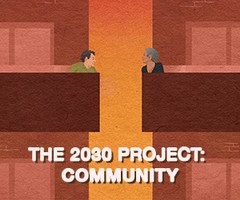The pandemic has been isolating. How do we build community in a fractured world? VMG’s 2030 Project residents interrogate how we can build a shared future, together.
Advertisement
In 1990, Congress passed the Native American Graves Protection and Repatriation Act with the intent to start righting this wrong. It provided a process for returning Native human remains, funerary and sacred objects, and objects of cultural patrimony to federally recognized tribes and Native Hawaiian and Native Alaskan organizations. Although this law was a step in the right direction, it should have been the bare minimum in the repatriation of ancestral remains and artifacts. It has been more than 30 years since the law passed, and many Native people are still having trouble getting their ancestors back. One problem is that some academics are not eager to make these rightful returns happen. This year at the Society for American Archaeology’s annual meeting, Elizabeth Weiss, a physical anthropology professor, argued against repatriation laws, saying that it embraces creationism and gives “control of research over to contemporary Indian communities.” The subtext in this argument suggests that Native peoples are somehow anti-science and completely ignores that there are Native archaeologists. It implies that Native peoples cannot share their history and that colonizers should tell their history without their consent.Over the last few years, tribal nations learned that some institutions were not even aware of the artifacts they possess. Under NAGPRA, institutions have to catalog the artifacts and Native remains they have, but this had not been done at the Archaeology Collection in Jackson, Mississippi, Southern Methodist University in Dallas, Texas, and Harvard Peabody Museum in Cambridge, Massachusetts, to name a few. The National Parks Service keeps track of NAGPRA human remains inventory, and estimates that as of September 30, 2020, 199,333 remains were in the system and only around 40 percent, or 83,076 remains, had been returned at that time. Because many institutions do not know what they have, the full numbers are likely much higher.
Advertisement
Other issues exist within NAGPRA itself. The law only applies to federal lands and has only been interpreted to support federally recognized tribes in this process. Non-federally recognized tribes must submit requests under a different NAGPRA provision for repatriation, but this provision only applies to ancestral human remains and does not guarantee the associated funerary objects’ return. It is important to note that the interpretation of this law could include non-federally recognized tribes, but it rarely does. Some tribal nations are working together to make this process easier.The Michigan Anishinaabek Cultural Preservation & Repatriation Alliance (MACPRA) is a combination of federally recognized tribes and state tribes in Michigan that work to give all tribes a voice in the repatriation process and keep state tribes updated with NAGPRA’s filing process. AAIA’s Program Director Colleen Medicine (Sault Ste. Marie Tribe of Chippewa Indians) said that these coalition efforts have brought different tribes closer together not only within the state but also between tribes in the US and Canada. “We've facilitated repatriations here in the US and then brought ancestors across the river to them [in Canada] because they don't have any standing here to do that,” Medicine said. Unfortunately, even during the repatriation process, museums and federal institutions can make determinations about which artifacts have a “cultural relationship” with a specific tribe. If they don’t establish this relationship, they will label the remains or artifacts as “culturally unidentifiable.” Shannon O’Loughlin, Chief Executive of the Association of American Indian Affairs, highlighted how problematic it is to even call an ancestor unidentifiable when they are “obviously identifiable to native nations whether the US has recognized that nation or not.” In the case of the Harvard Peabody Museum, the Association accused the museum of breaking NAGPRA laws and resisting the repatriation process. “Their resistance methodology was to paper it with their lawyers. So they put a lot of money and a lot of time into ‘let's build the evidence against affiliation to tribes’. So if [Peabody] papers the evidence with so much material, whether it's true or theories or assumptions, tribes will not be able to prove their burden or what they think is the tribe's burden to prove affiliation,” O’Loughlin said. The Peabody Museum Director Jane Pickering issued an apology earlier this year to the Association and vowed to “prioritize the urgent work of understanding and illuminating our history and to begin to make amends.” Thirty years after the passing of NAGPRA, tribal nations are still fighting for their rights under an already-established law. NAGPRA was supposed to be a beginning step; however, it is still being violated today. O’Loughlin details the emotional toll this process has on Native peoples. “When indigenous people go into these institutions, click on eBay, or watch PBS Antiques Roadshow, they see their tribal items talked about like pieces of commodity and not things with life that are supposed to be working to preserve the health, safety, and welfare of their nation. It's a continuing emotional, spiritual harm that tribes face,” she said. By 2030, Medicine and O’Loughlin hope that the landscape will be different. Medicine wants to “see repatriation include language and ceremony and other things that were taken without consent as well.” “We're trying to create a world where diverse Native American cultures and values are lived, protected, and respected,” O’Loughlin said. “What I'm hoping to see, and I don't know if we'll get there in 10 years, is a full-on change of how we see Native American objects and ownership. It's not okay to have these things, but it's okay to look at contemporary Native American artists and purchase the things that are meant to be shared. [It’s okay] to be involved in the places and with the people who are able to share certain things about the culture and religion of Native America, and respect when those things are not open to the public.”
